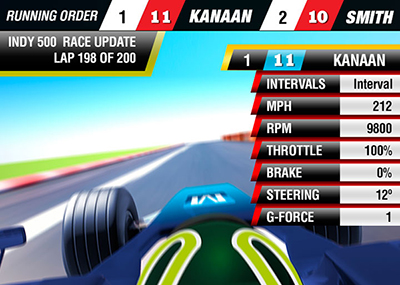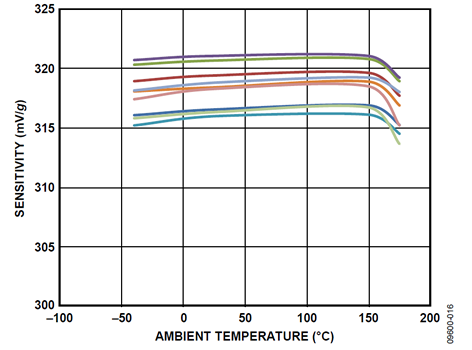Auto racing, and all broadcast spectator sports for that matter, has changed dramatically in the last decade. Thanks to telemetry, which is a fancy word for remote monitoring, race fans can monitor the individual performance of each racing team and listen in-car chatter with radio scanners or via official subscriptions to wireless data and streaming video feeds. Racing fans can switch between drivers' in-car cameras, viewing from their mobile phones in the stands.
Telemetry for 80 or more sensors on one car is not uncommon in racing. Data from each sensor can be fed live from the car to the pit crew and driver at between 10 – 20 samples per second, or in more copious amounts to an on-board data logger at up to 100 samples per second; and this is in monitoring a single piece of data. Information is displayed to the driver, the pit crew, the fans, and recorded in a data logger and in a car “black box.” Multiply that by 80 or more sensors, and there's a large amount of data to analyze, mainly for performance improvement.
Figure 1:Telemetry Example
An illustration of video broadcasting of the telemetry data transmitted from a race car.

Mouser Engineers met with Josh Fults and Matt Cummings, Data Acquisition Engineers from KV Racing, to talk shop about working with electronics in a racing environment. Hands-down, they said one of the biggest challenges is vibration. Vibration behaves differently at each new track. The team races more than half of the year at many different venues. When the car is going 200MPH, minor issues with each new track become like pot holes with respect to vibration, except they happen repetitively. The sensors have got to be tough.
What does an Indy series race team monitor? Information that is either displayed real time or recorded for post-race analysis is engine load or manifold absolute pressure (aka “boost”), RPMs, throttle position, air and water temperatures, fuel level, tire pressure, the percentage of oxygen in the exhaust (a measure of fuel/air mixture), roll bar position, and detailed information such as 3-axis acceleration, mechanical displacement, and rotational speed.
Cars race at 200MPH while maintaining a position within inches of each other, and race officials are tracking car positions to an accuracy of a couple of centimeters. Broadcasters flip a switch and an overlay of 6 or 7 stats on a driver pops up and fans can see pertinent telemetry data like MPH, RPM, the exact rotation of the steering wheel, and how much throttle, braking, and g-force is being applied at that moment. Reality has become virtual: the driver is experiencing the very real effects of that data right now. The virtual has become reality: it is easy to become a virtual back-seat driver, second-guessing the driver' overtake strategies and feeling the limitations of the car right along with them.
Telemetry brings this to you. The sensors have got to be able to take a beating, with high temperatures in the engine, constant vibration, dust, dirt, water, oil and other environmental cruelties. Electronics especially manufactured to take a beating are high performance, high temperature devices like the ADXL206 MEMS accelerometer from Analog Devices. The ADXL206 is rated to withstand temperatures that are also suitable for geological exploration at 175°C (ambient) and g-forces to ± 5g with a good degree of linearity. It's not uncommon to deal with 4.5 Gs while cornering on certain tracks. Murata supplies another MEMS accelerometer, the SCA3100-D07-1, which goes to 6 Gs and operates in brutal 125°C temperatures. Murata hermetically seals their MEMS gyroscopes and accelerometers at the wafer level, providing protection from particles and chemicals.
Figure 2: ADXL206High Temp MEMS Accelerometer: X-Axis Sensitivity over Temperature, Nine Devices (Courtesy ADI)

A race car driver in the Indy 500 has to hold their head up against 3 – 4 Gs in cornering for 200 laps. This is done in high humidity and temperatures in the 90s.
Other sensors that make sense in racing are contact-less. Honeywell Digital Hall-Effect Sensors are small, highly sensitive devices designed to respond to alternating North and South poles. This is ideal for speed sensing and RPM measurement, although they can also be used for position sensing. All of these sensors require connectors and communications transceivers. The KV Racing team makes use of the CAN protocol for in-car networking. CAN transceivers provide the protocol and means to network data throughout a car, sending data from a hall sensor to the Engine Control Unit (ECU) via the communications bus in a harness they call a “loom” rather than running multiple direct wires. Microchip, Infineon, ON Semiconductor and NXP offer CAN transceivers that operate in temperatures approaching 150°C.
Hardware and software engineers have brought high-tech to sports. They now take relevant sensor data directly from the cars and display it real-time on broadcast television. So whenever you look at a car race again and you see multiple stats on-screen, imagine that a decade from now you might actually be in a simulator that uses the information from all those tiny-yet-tough sensors to emulate a virtual in-car experience for you. What could be better than a full, but vicarious experience without the danger? Engineers continue to bring these opportunities to us by stretching the limits of designs with new technology and in new products as offered by distributors like Mouser Electronics, which has over 3 million product SKUs to choose from. The KV Racing team uses Mouser products to create custom solutions. So can you.
Advertisement
Learn more about Mouser Electronics





